Switching to LED lighting presents substantial environmental advantages, including decreased energy consumption, reduced carbon emissions, and minimized light pollution. By opting for LEDs over traditional lighting solutions, individuals and businesses not only lower their energy bills but also contribute to a more sustainable future.
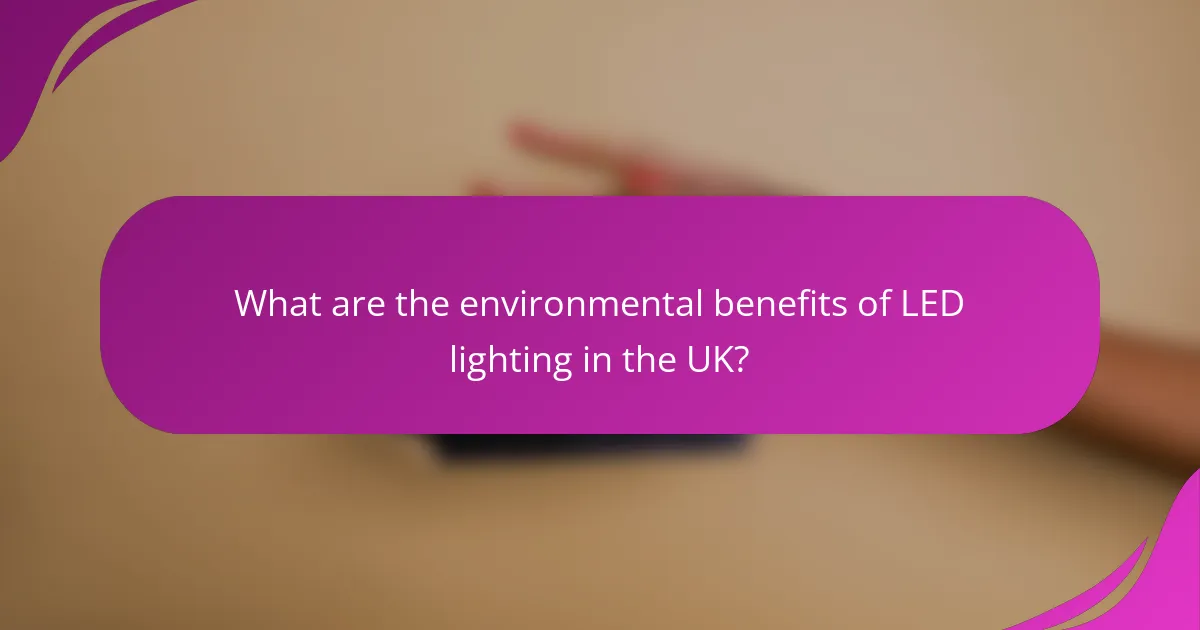
What are the environmental benefits of LED lighting in the UK?
LED lighting offers significant environmental benefits in the UK, primarily through reduced energy usage, lower carbon emissions, and less light pollution. By making the switch to LED, individuals and businesses can contribute to a more sustainable future.
Reduced energy consumption
LED lights are highly energy-efficient, using up to 80% less electricity compared to traditional incandescent bulbs. This reduction in energy consumption not only lowers electricity bills but also decreases the demand on power plants, leading to a more sustainable energy grid.
For example, replacing a standard 60-watt incandescent bulb with a 10-watt LED can save approximately 50 watts per bulb. Over time, these savings can add up significantly, especially in larger installations.
Lower carbon emissions
Switching to LED lighting results in lower carbon emissions, as less energy consumption translates to reduced greenhouse gas emissions from power generation. In the UK, where a significant portion of electricity is generated from fossil fuels, this shift can have a meaningful impact on overall carbon footprints.
By using LEDs, households and businesses can collectively reduce their carbon emissions by millions of tons annually, contributing to the UK’s climate goals and commitments under international agreements.
Minimized light pollution
LED lighting can help minimize light pollution, which affects both wildlife and human health. Unlike traditional lighting, LEDs can be designed to direct light precisely where it is needed, reducing unnecessary glare and skyglow.
By using LED fixtures with proper shielding, urban areas can enhance visibility while preserving the natural night sky, benefiting both ecosystems and residents who seek to enjoy stargazing.
Longer lifespan and waste reduction
LED bulbs have a significantly longer lifespan, lasting up to 25,000 hours or more, compared to around 1,000 hours for incandescent bulbs. This longevity means fewer replacements and less waste generated over time.
As a result, switching to LED lighting not only reduces the frequency of disposal but also lessens the environmental impact associated with manufacturing and transporting replacement bulbs, contributing to a more circular economy.
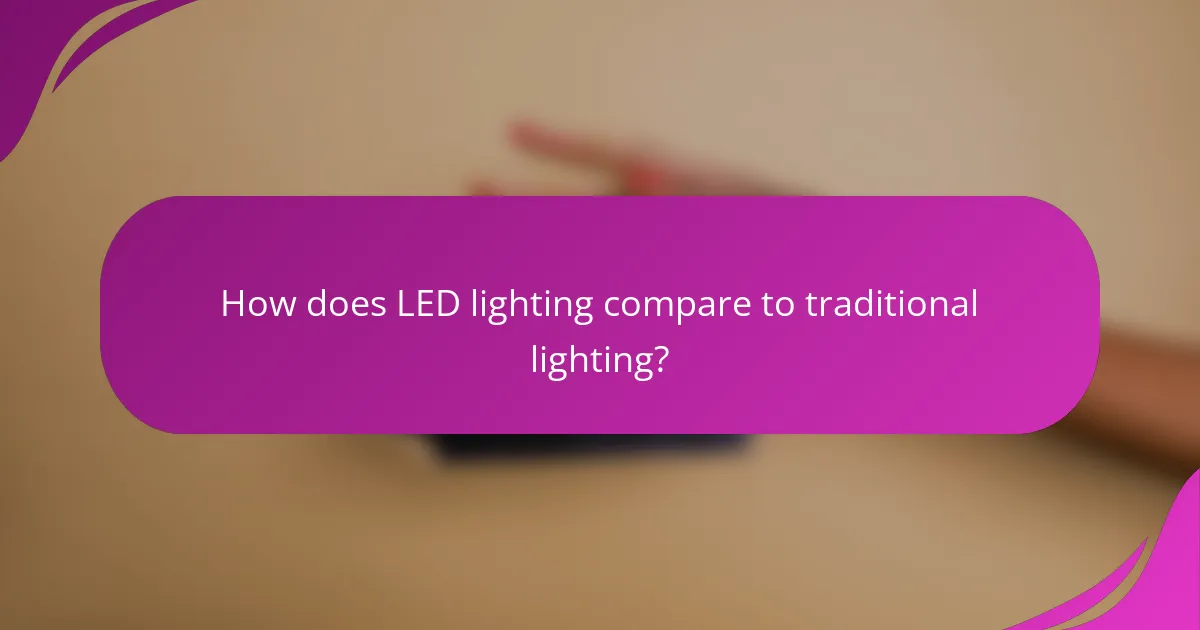
How does LED lighting compare to traditional lighting?
LED lighting significantly outperforms traditional lighting options, such as incandescent and fluorescent bulbs, in terms of energy consumption, lifespan, and overall efficiency. By switching to LED, users can expect lower energy bills and reduced environmental impact.
Energy efficiency comparison
LED lights are known for their superior energy efficiency, using up to 80% less energy than incandescent bulbs. While traditional bulbs convert much of their energy into heat, LEDs convert most of their energy into light, resulting in less wasted energy.
This efficiency translates into lower electricity usage, which is particularly beneficial in regions with high energy costs. For example, replacing a 60-watt incandescent bulb with a 10-watt LED can lead to significant savings on monthly energy bills.
Cost savings over time
Although LED bulbs may have a higher upfront cost compared to traditional lighting, their long lifespan and reduced energy consumption lead to substantial savings over time. An LED bulb can last up to 25,000 hours, while incandescent bulbs typically last around 1,000 hours.
Considering the average cost of electricity, switching to LED lighting can save households and businesses hundreds of dollars over several years. For instance, if a household replaces ten incandescent bulbs with LEDs, the savings can accumulate to several hundred dollars in energy costs alone.
Environmental impact analysis
The environmental benefits of LED lighting are significant, primarily due to reduced energy consumption and lower greenhouse gas emissions. By using less electricity, LEDs contribute to a decrease in fossil fuel use, which is a major source of carbon emissions.
Additionally, LEDs do not contain hazardous materials like mercury, which is found in some traditional bulbs. This makes them safer for disposal and reduces the risk of environmental contamination. Overall, the shift to LED lighting supports sustainability efforts and helps combat climate change.
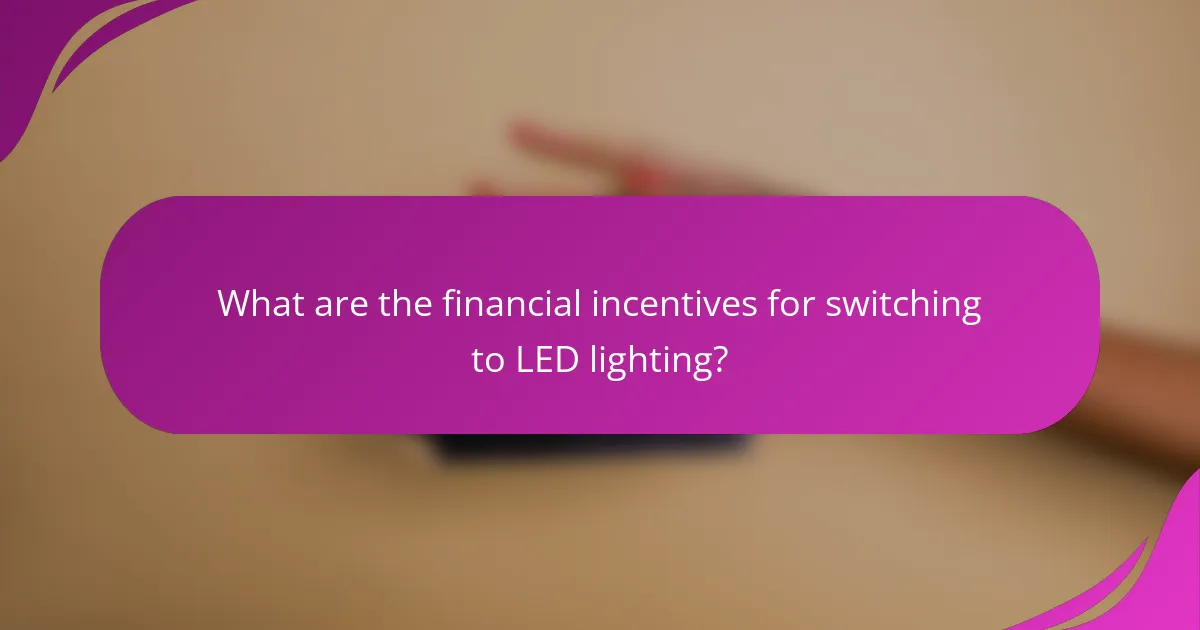
What are the financial incentives for switching to LED lighting?
Switching to LED lighting can lead to various financial incentives, including government rebates, tax benefits, and significant long-term savings on electricity bills. These incentives can help offset the initial investment in LED technology, making it a more attractive option for both homeowners and businesses.
Government rebates in the UK
The UK government offers several rebate programs to encourage the adoption of energy-efficient lighting solutions like LEDs. These rebates can significantly reduce the upfront costs associated with purchasing and installing LED lights.
Local councils and energy suppliers often provide financial incentives, which can vary by region. It’s advisable to check with your local authority or energy provider for specific rebate programs available in your area.
Tax benefits for businesses
Businesses that switch to LED lighting may qualify for various tax benefits, such as capital allowances. This allows companies to deduct a portion of the cost of their LED installations from their taxable profits, effectively reducing their tax burden.
Additionally, some businesses may be eligible for enhanced capital allowances (ECAs) for energy-saving technologies, which can provide a more substantial tax relief. Consulting with a tax advisor can help identify all applicable benefits.
Long-term savings on electricity bills
One of the most compelling reasons to switch to LED lighting is the potential for long-term savings on electricity bills. LEDs are significantly more energy-efficient than traditional lighting, often using up to 80% less energy, which translates into lower monthly utility costs.
Over time, the savings on electricity can offset the initial investment in LED technology, with many users reporting payback periods of just a few years. Regularly monitoring energy consumption can help track savings and validate the financial benefits of switching to LEDs.

What are the best practices for implementing LED lighting?
To effectively implement LED lighting, focus on selecting quality products, ensuring proper installation, and considering energy efficiency. These practices can enhance performance and maximize the environmental benefits of LEDs.
Choosing the right LED products
Selecting the right LED products involves understanding your specific lighting needs and the characteristics of available options. Look for products that are ENERGY STAR certified, as they meet strict efficiency and performance standards.
Consider the color temperature, which is measured in Kelvin (K). For warm environments, choose bulbs around 2700K to 3000K, while cooler settings may benefit from 4000K to 5000K. Additionally, check the lumens output to ensure adequate brightness for your space.
Installation tips for optimal performance
Proper installation is crucial for maximizing the performance of LED lighting. Ensure that fixtures are compatible with LED bulbs, as some older fixtures may not support them effectively. Use dimmers specifically designed for LED technology to avoid flickering and prolong bulb life.
Position lights strategically to minimize shadows and maximize illumination. For outdoor installations, consider weatherproof fixtures to protect against the elements. Regularly check connections and fixtures to maintain optimal performance and safety.
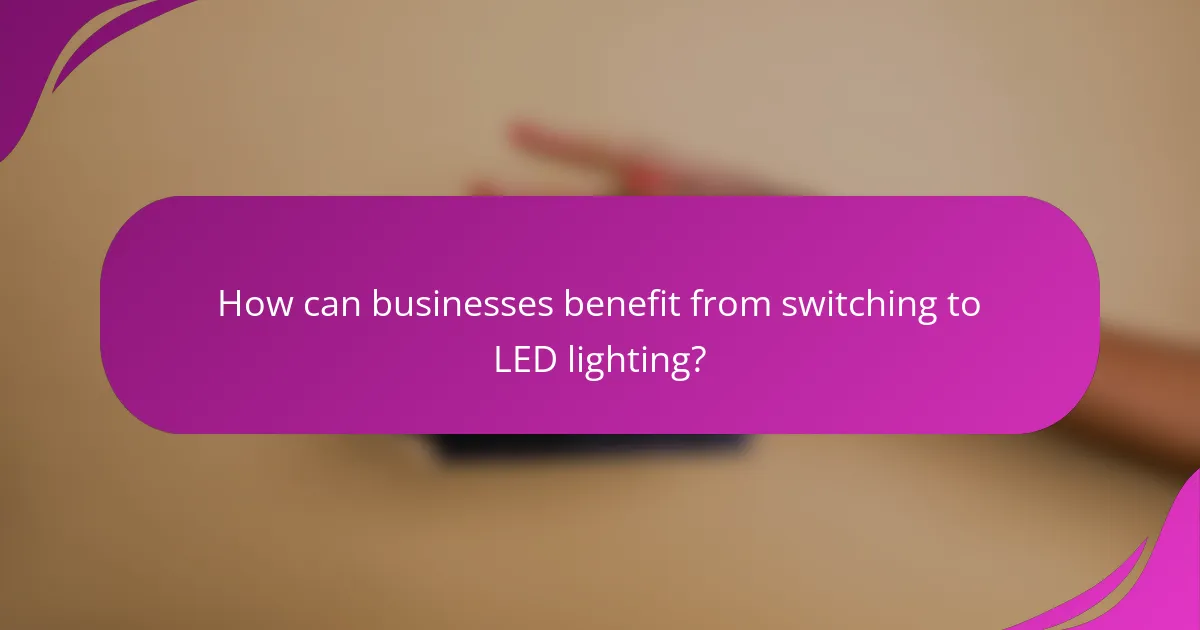
How can businesses benefit from switching to LED lighting?
Businesses can significantly benefit from switching to LED lighting through cost savings, enhanced brand image, and improved employee productivity. By adopting energy-efficient LED technology, companies can lower their energy bills and reduce maintenance costs, while also demonstrating a commitment to sustainability.
Enhanced brand image
Switching to LED lighting can enhance a business’s brand image by showcasing a commitment to sustainability and environmental responsibility. Customers increasingly prefer to support companies that prioritize eco-friendly practices, which can lead to increased loyalty and positive word-of-mouth.
Additionally, well-lit spaces using LED technology can create a more inviting atmosphere, improving customer experiences and perceptions of the brand. This can be particularly beneficial for retail environments where ambiance plays a crucial role in purchasing decisions.
Improved employee productivity
LED lighting can improve employee productivity by providing better quality light that reduces eye strain and enhances focus. Studies suggest that environments with appropriate lighting can lead to higher levels of engagement and efficiency among staff.
Moreover, LED lights can be designed to mimic natural daylight, which has been shown to positively affect mood and energy levels. This can lead to a more motivated workforce and lower absenteeism rates, ultimately benefiting the business’s bottom line.
Compliance with environmental regulations
Switching to LED lighting helps businesses comply with various environmental regulations aimed at reducing energy consumption and greenhouse gas emissions. Many countries and regions offer incentives for companies that adopt energy-efficient technologies, making the transition financially attractive.
Furthermore, using LED lighting can help businesses meet specific energy performance standards, such as those outlined in the Energy Star program in the United States or similar regulations in Europe. Compliance not only avoids potential fines but can also enhance a company’s reputation as a responsible corporate citizen.
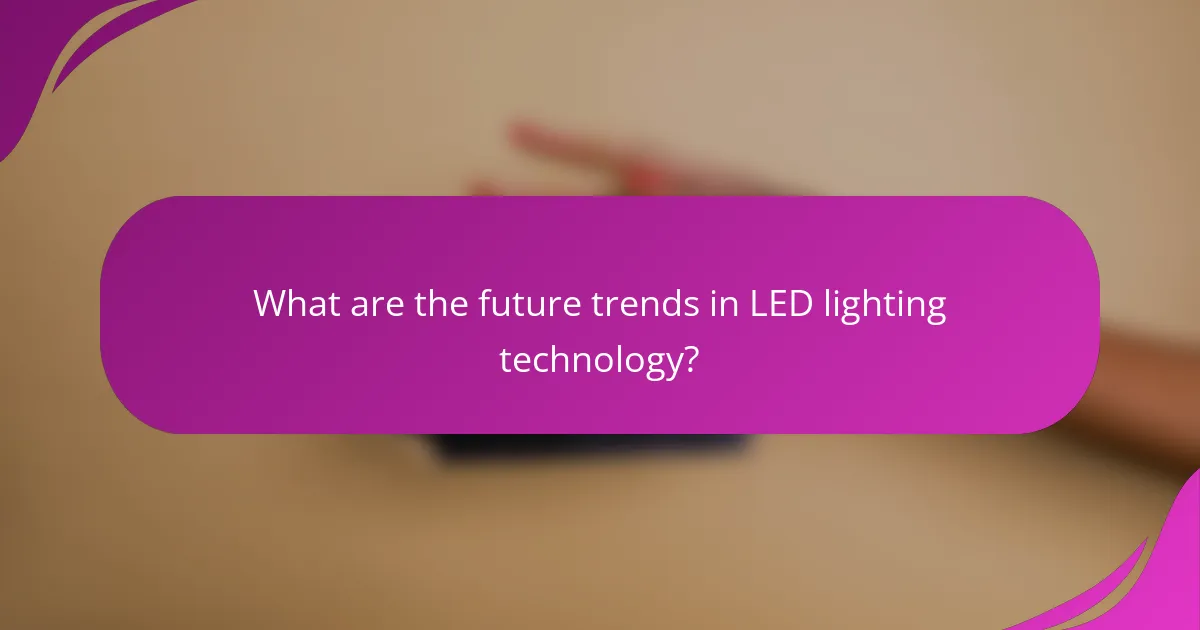
What are the future trends in LED lighting technology?
Future trends in LED lighting technology focus on enhanced integration with smart systems and significant advancements in energy efficiency. These developments aim to improve user experience, reduce energy consumption, and lower costs over time.
Smart lighting integration
Smart lighting integration involves connecting LED systems to home automation networks, allowing users to control lighting remotely via smartphones or voice commands. This technology enables features such as scheduling, dimming, and color adjustments based on user preferences or environmental conditions.
For example, smart LED bulbs can automatically adjust brightness based on the time of day or occupancy, leading to energy savings. Homeowners can also set scenes for different activities, enhancing comfort and functionality.
Advancements in energy efficiency
Advancements in energy efficiency for LED lighting focus on improving lumens per watt, which measures the amount of light produced for each watt of electricity consumed. Newer LED technologies can achieve efficiencies exceeding 150 lumens per watt, significantly reducing energy costs.
Additionally, the development of better thermal management systems helps prolong the lifespan of LEDs, often exceeding 25,000 hours. This longevity reduces the frequency of replacements, contributing to lower waste and maintenance costs.


